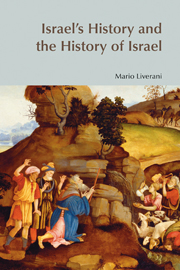Book contents
- Frontmatter
- Dedication
- Contents
- List of Tables and Illustrations
- Foreword
- Abbreviations
- IMPRINTING
- Part I A NORMAL HISTORY
- Chapter 2 THE TRANSITION (TWELFTH CENTURY)
- Chapter 3 THE NEW SOCIETY (c. 1150–1050)
- Chapter 4 THE FORMATIVE PROCESS (c. 1050–930)
- Chapter 5 THE KINGDOM OF ISRAEL (c. 930–740)
- Chapter 6 THE KINGDOM OF JUDAH (c. 930–720)
- Chapter 7 THE IMPACT OF THE ASSYRIAN EMPIRE (c. 740–640)
- Chapter 8 PAUSE BETWEEN TWO EMPIRES (c. 640–610)
- Chapter 9 THE IMPACT OF THE BABYLONIAN EMPIRE (c. 610–585)
- INTERMEZZO
- Part II AN INVENTED HISTORY
- EPILOGUE
- Bibliography
- Index of References
- Index of Names of Persons and Deities
- Index of Placenames
Chapter 3 - THE NEW SOCIETY (c. 1150–1050)
from Part I - A NORMAL HISTORY
- Frontmatter
- Dedication
- Contents
- List of Tables and Illustrations
- Foreword
- Abbreviations
- IMPRINTING
- Part I A NORMAL HISTORY
- Chapter 2 THE TRANSITION (TWELFTH CENTURY)
- Chapter 3 THE NEW SOCIETY (c. 1150–1050)
- Chapter 4 THE FORMATIVE PROCESS (c. 1050–930)
- Chapter 5 THE KINGDOM OF ISRAEL (c. 930–740)
- Chapter 6 THE KINGDOM OF JUDAH (c. 930–720)
- Chapter 7 THE IMPACT OF THE ASSYRIAN EMPIRE (c. 740–640)
- Chapter 8 PAUSE BETWEEN TWO EMPIRES (c. 640–610)
- Chapter 9 THE IMPACT OF THE BABYLONIAN EMPIRE (c. 610–585)
- INTERMEZZO
- Part II AN INVENTED HISTORY
- EPILOGUE
- Bibliography
- Index of References
- Index of Names of Persons and Deities
- Index of Placenames
Summary
Distribution of Settlements
The most significant phenomenon in terms of settlement, and the most characteristic of the ‘new society’, is the occupation of the highlands by an agro-pastoral population that built small hilltop villages. Recent intensive surveys by Israeli archaeologists have made possible a reliable, regionally diversified picture of this settlement by identifying more than 250 sites from Iron Age I. The population that occupied these villages was probably a mix of existing tribal elements reinforced demographically and socioeconomically by people of an agricultural origin, fleeing the control of the palace, as described in §§1.10 and 2.5. These can be defined ‘proto-Israelite’. Strictly speaking, the term ‘Israelite’ should be reserved for members of the kingdom of Israel, but the name ‘Israel’ already appears in a text from the end of the thirteenth century (a stele of Merenptah, §1.9), referring precisely to this new ethnic complex already in process of formation and identifiable as such.
The new village society is not entirely homogeneous nor did it emerge all at once. In the areas already partially occupied in the twelfth century (Manasseh and Lower Galilee) we find a greater continuity with the Late Bronze Age ‘Canaanite’ culture, whereas occupation was radically different in zones where living conditions were harder and therefore had been without permanent settlement for several centuries (Ephraim and Benjamin, Upper Galilee and, later, the Negev).
- Type
- Chapter
- Information
- Israel's History and the History of Israel , pp. 52 - 76Publisher: Acumen PublishingPrint publication year: 2005



